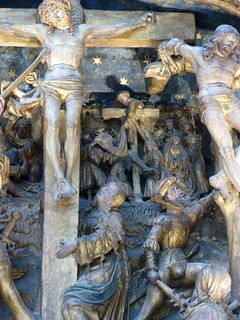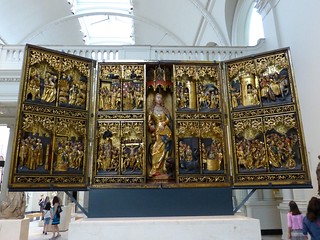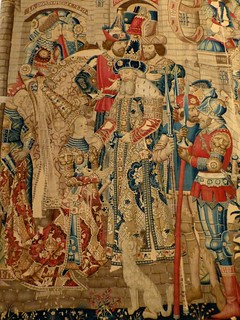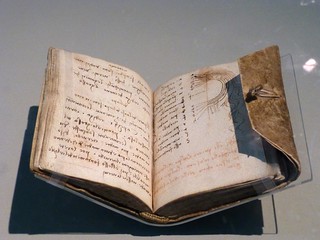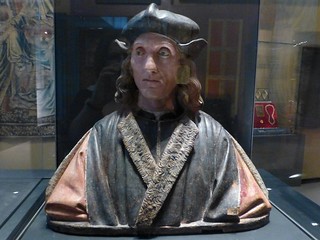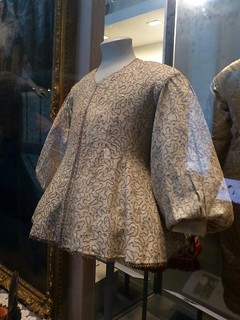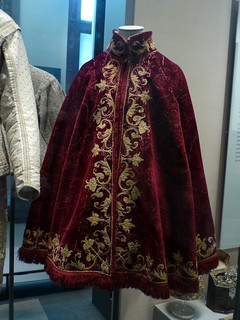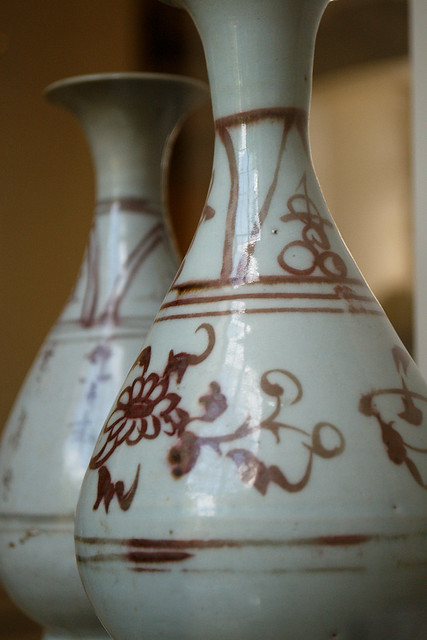Indian Ocean with Simon Reeve
The second leg of Simon Reeve’s trip round the Indian Ocean covered three island nations off the coast of East Africa. For Madagascar Reeve concentrated on the bits of the island that aren’t protected wildlife preserves, so in contrast to the imagery one normally sees there were a lot of shots of deforested farmland. And that deforestation has had the predictable results of altering water flow patterns, causing flooding & destruction. (There were some shot of cute lemurs as well, but very much not the primary focus.)
From poverty & environmental destruction in Madagascar he moved on to wealth & … environmental destruction in Mauritius. Tuna fishing was the primary culprit here – the sort of dredge up everything in the sea and sort the tuna fish out later approach to fishing. He’d originally been given permission to film in the harbour, but that was withdrawn.
As a contrast the Seychelles segment was mostly focussing on environmental re-creation. Reeve visited a British man who bought an island in the Seychelles in the 1960s for around £8000, and he’s spent the time since then making the island into a perfect habit for himself and his giant tortoises. It wasn’t clear if there was any other people on the island with him, but definitely lots of tortoises!
That episode finished up with a segment about Somali pirates & the Dutch soldiers who’re trying to rescue the boats captured by these pirates. This lead nicely into the next episode which we watched a few days later. In it Reeve travelled from Kenya through Somalia to Somaliland, finishing off the African leg of his journey. Throughout the programme there was an air of suppressed hysteria, because for the middle part of it Reeve was visiting Mogadishu, the capital city of Somalia.
The Kenya leg of the journey was mostly focussed on an area of abundant & impressive wildlife – the Tana River Delta. Sadly a lot of the land is being given over to sugar cane plantations, which not only gets rid of all the wildlife, but also involves moving on the people who make their homes there. Reeve also visited a village at the northern end of the Kenyan coastline where the villagers earn their livings by making flipflops that wash up on their beaches into ornaments & toys. That’s only a fraction of the plastic that washes up on the shoreline, but it’s the bit they’ve come up with a way to make money from.
The men in that last village no longer fish because of piracy, which led nicely into the next segment where Reeve went to Mogadishu. Much respect to Reeve for going there – it looked terrifying. He was with one of the AMISOM regiments (the African Union peacekeeping force that’s there), as that was safest, and they took him out to the front lines in the city – at one point moving him & his camera crew away quickly because it looked like the Somali al-Shabab militants were about to attack. He also visited a food station – a lot of refugees have come to Mogadishu because there are places they can get food (foreign aid has been prevented from reaching other parts of the country), and despite how dreadful conditions are in the capital they are still better than elsewhere in the country.
From there Reeve flew to Somaliland, which has broken away from Somalia but is not recognised as a separate country by the UN. So it’s in a sort of limbo, but it’s a limbo that has law & order and a much more functional state apparatus than war-torn Somalia. Here Reeve didn’t just visit & talk to refugees from Somalia, he also talked to a Somali pirate who has been captured & jailed in Somaliland. The man was completely unrepentant. While he spun it as “we’re just trying to protect our fishing rights from the big corporate tankers” for the start of piracy, he was also completely upfront that there was money to be made in taking people hostage or taking their goods and felt that was a reasonable thing to be doing. He was sort of justifying it by saying that because his country was so war torn there’s no other way to make money to get food/whatever so terrorising the seas was the obvious choice.
Who Were the Greeks?
The second & final episode of Who Were the Greeks? was more focussed on the things that have left a lasting legacy down to our time. So he looked at things like the Olympics, which are both like our current games and very much not. For instance one difference was that winning was all that mattered in Ancient Greece, none of this “it’s the taking part that counts” or doing your best, you either won or you didn’t. Another thing he looked at was the architecture & sculpture that has survived since Ancient Greek times, concentrating particularly on how our ideas about what it looks like are heavily influenced by the fact that the paint has disappeared over time. There was an interview with one expert who said he rather hoped that people forget again about the paint (as has apparently happened before) so that future generations can have the joy of this discovery. I was unconvinced, it has to be said 😉 Maybe if they remember the paint they might have the joy of other discoveries we haven’t got to yet rather than just repeating the past.
And he finished up the programme by looking at how come Greek culture spread so far from Greece. Part of this is down to Alexander the Great, who in the process of conquering a lot of the then known world managed to spread Greek culture behind him as he went. And then after the Romans conquered the Greeks they assimilated Greek culture into their own & spread it further still.
Britain’s Stone Age Tsunami
Another Time Team Special that we had recorded was one about a tsunami that hit Britain 8000 years ago. This event played a part in the splitting of Britain from mainland Europe. There’s definitely evidence for some sort of catastrophic flooding event in the north-eastern coast of Britain, in the form of a layer of sand which contains deep sea diatoms. The tsunami was triggered by an undersea earthquake out somewhere north of Norway, it in its turn was likely triggered by changes in the crust due to the retreating glaciers.
The people living in Britain & Doggerland (the name of the land linking Britain to the European mainland) at the time are often thought of as “primitive hunter gatherers”, but there’s increasing evidence that this was not the case. A major part of this programme was talking to the woman running an excavation in York of a Mesolithic village. It dates to around the same time as the tsunami & is a least a semi-permanent settlement with houses constructed from timber.
A minimum amount of padding in this programme, although we did roll our eyes somewhat when they suddenly launched into a flight of fancy about how something was “clearly” a spiritual item used by shamans. Well, you can’t tell, can you? It’s not like they left a little note next to it saying “holy object” 😉
Ancient Apocalypse: Sodom & Gomorrah
Sadly the last episode of the Ancient Apocalypse series had enough padding to bring the average padding/programme for all the other programmes we watched this week back up to “high”. It was about the biblical story of Sodom & Gomorrah, and whether or not it was based on a real event. And this retired engineer had a theory, but needed facts to prove it. And then he talked to some scientists. They thought he had a theory, but needed facts to prove it. They found some facts. He had a theory, and needed facts to prove it. Someone did an experiment. He had a theory, but needed facts to prove it. Oh look, this theory fits the facts, but it’s not proven yet. Each time they explained the theory it was the same one, they were really just spinning their wheels.
However, mockery aside there was a kernel of a programme there. The basic idea was that when Genesis came to be written down it included folk tales that were fitted into the overall Jewish-centric narrative. One of these might’ve been a memory of a devastating earthquake in the Dead Sea region that is turned into an example of God’s wrath striking down the wicked. Over the course of the programme they did show evidence that there were settlements we could call cities in the Dead Sea region in the early Bronze Age. They also showed that this was & is an earthquake prone zone, with signs that an earthquake did happen around the right time for it to affect the people in the cities. There were also a couple of added bonus destructive properties over “normal” earthquakes. The first of these is that there’s a lot of methane trapped in the rocks underground, which an earthquake could release to ignite fires (hence the fire & brimstone bit of the tale). The second is that the ground around the Dead Sea is made up of rock that will liquefy under earthquake conditions, which could then trigger a landslide tipping the houses of a settlement into the Dead Sea if they were close enough. The cities might be close enough because you can harvest asphalt out of the Dead Sea and that was a valuable trade item at the time. So maybe all of that happened, and was passed down as a folk tale that made it into the Bible. But there’s no proof, just a lot of it-could-be-possibles.
But it felt like at least half of the 50 minute programme was taken up with telling us this man had a theory, telling us what the theory was, and telling us he needed facts to prove it. Then a bit of shaky cam stuff to make us think about the earth shaking.
I was disappointed with the series overall, it felt like a good idea let down by an overly padded and gee-whiz execution.

